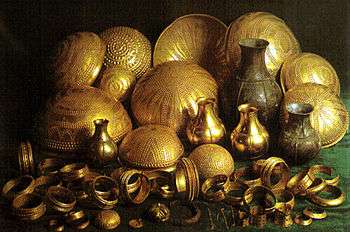José María Soler García
| José María Soler García | |
|---|---|
|
Monument to José María Soler in Villena | |
| Born |
September 30, 1905 Villena |
| Died |
August 25, 1996 Villena |
| Occupation | Archaeologist, Historian, Researcher, Folklorist, Mail carrier, Accountant |
| Language | Spanish |
| Nationality | Spanish |
| Citizenship | Spain |
| Period | 1930-1996 |

José María Soler García was a Spanish archaeologist, historian, researcher and folklorist. He is one of the persons who most deeply studied Villena and its surrounding area, since the vast majority of his research was focused on what concerned his hometown.
In 1957 he founded Villena's Archaeological Museum with the findings he had collected from the 1920s on. In 1963, after he found the Treasure of the Cabezo Redondo in March and the Treasure of Villena in December, the museum's name was officially changed to Archaeological Museum "José María Soler". The José María Soler Foundation,[2] constituted after his death, calls every year Research Awards in order to keep alive Soler's legacy.[3]
Publications
Soler has written several books on his archaeological works, some others on historical or folkloric research and even one dictionary on Villena's Spanish dialect. Moreover, he has written a hugh quantity of articles in newspapers and magazines, and he has also given many lectures all over Spain. A list of their published books follows:[4]
- Archaeology
- 1956. El yacimiento musteriense de "La Cueva del Cochino" (Villena-Alicante)
- 1965. El tesoro de Villena
- 1969. El oro de los tesoros de Villena
- 1981. El Eneolítico en Villena
- 1987. Excavaciones arqueológicas en el Cabezo Redondo (Villena, Alicante)
- 1991. La Cueva del Lagrimal
- 1993. Guía de los yacimientos y del Museo de Villena
- History
- 1948. Crónica de las Fiestas de septiembre de 1948
- 1969. La Relación de Villena de 1575
- 1976. Villena: Prehistoria - Historia - Monumentos
- 1981-1988. Historia de Villena
- 1993. La colección numismática de José Mª Soler
- 2006. Historia de Villena: desde la Prehistoria hasta el siglo XVIII (re-ed. 2009)
- Linguistics
- 1993. Dicionario villenero (reed. 2005)
- Music and folklore
- 1979. El Polifonista villenense Ambrosio Cotes
- 1986. Cancionero popular de Villena (re-ed. 2005)[5]
- Other themes
- 1958. Bibliografía de Villena y su Partido Judicial
- 1976. I Congreso Nacional de Fiestas de Moros y Cristianos
- 1984. Soldadescas, Comparsas y Toros
Awards
- Musicology Award of CSIC, on the Cancionero popular de Villena (1949)[6]
- Golden Medal of Villena (1973)[7]
- Bronze Medal in Fine Arts (1980)[7]
- Montaigne Award of Hamburg's FvS Foundation (1981)[8][9]
- Doctor honoris causa by Universidad de Alicante (1985)[8]
- Gold Medal of the Province of Alicante (1991)[8]
In addition, Villena's City Hall gave his name to one street in the old part of the city in 1979.
References
- ↑ "RESOLUCIÓN de 7 de enero de 2003, de la Dirección General de Patrimonio Artístico de la Consejería de Cultura y Educación, por la que se incoa expediente de declaración de bien de interés cultural a favor de la colección arqueológica del Tesoro de Villena." [January 7, 2003, RESOLUTION of the General Direction on Artistic Heritage of the Culture and Education Council, which opens a file on the declaration as Good of Cultural Interest (BIC) the archaeologic collection known as Treasure of Villena] (pdf). [Spanish] State Official Bulletin (BOE) (in Spanish). Madrid: Spanish Government (49): 7798–7802. 26 February 2003. Retrieved December 6, 2009.
Desde el punto de vista histórico, artístico y arqueológico, el Tesoro de Villena constituye un «unicum», un depósito no normalizado, por su peso y contenido (A. Perea). De hecho, se trata del segundo tesoro de vajilla áurea más importante de Europa, tras el de las Tumbas Reales de Micenas en Grecia (A. Mederos). [From a historic, artistic and archaeological point of view, the Treasure of Villena constitues a "unicum", a non-normalised deposit, according to its weight and content (A. Perea). In fact, it is the second most important golden tableware finding in Europe, after that of the Royal Graves in Mycenae in Greece (A. Mederos)]
|first1=missing|last1=in Authors list (help) - ↑ Web site of the José María Soler Foundation
- ↑ "La Fundación José María Soler convoca los premios de investigación" [José María Soler Foundation calls the research awards]. Diario Información (in Spanish). April 17, 2009. Retrieved November 5, 2009.
- ↑ "Legado y obra" [Legacy & Work] (in Spanish). 2009. Retrieved November 30, 2009.
|first1=missing|last1=in Authors list (help) - ↑ "Presentado el Cancionero de Soler" [Soler's Cancionero presented] (in Spanish). February 6, 2006. Retrieved October 21, 2009.
|first1=missing|last1=in Authors list (help) - ↑ "Cancionero Popular de Villena". Gran Enciclopedia Temática de la Comunidad Valenciana. Literatura. Editorial Prensa Valenciana. 2009.
- 1 2 3 SOLER GARCÍA, José María (2006). "José María Soler García. Villena (1905-1996)" (PDF). Historia de Villena: desde la Prehistoria hasta el siglo XVIII (in Spanish). Villena: Fundación Municipal José María Soler. Retrieved August 12, 2009.
- ↑ Montaigne-Preis, ed. (1982). "Verleihung des Montaigne-Preises 1982 an Señor Don José María Soler García, Villena und des Montaigne-Studienstipendiums an Pedro Marco, Villena, am 11.Dezember 1981 in Madrid" (in German and Spanish). Hamburg: Digitalized by Biblioteca Virtual Miguel de Cervantes, 2005. Retrieved December 3, 2009.
|first1=missing|last1=in Authors list (help)